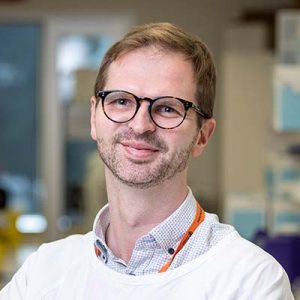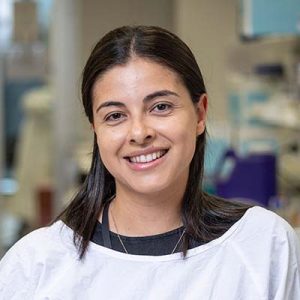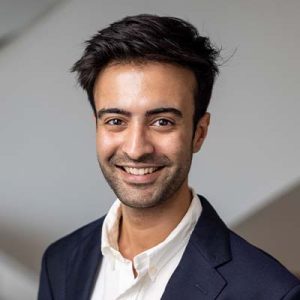Meet our Researchers
Growing up in England, I completed my undergraduate and master’s degree in Biomaterial Science and Tissue Engineering at the University of Sheffield, UK. After a short period as a research assistant in Sheffield, I then undertook a PhD in pathology at the University of Cambridge, UK. At this point, I decided it was best I left rainy England and set sights for brighter (and sunnier) pastures. I was then fortunate enough to secure a position as a Postdoctoral Research Associate in Associate Professor Dr James Chong’s Cardiac Regeneration Laboratory at the Westmead Institute for Medical Research, Sydney. During this time, I investigated novel therapeutics to treat heart failure and their underlying mechanisms.
Learn more about Dr. Hume’s lifesaving research
I have recently started a Postdoctoral Fellowship at The Baird Institute within the newly established Centre for Heart Failure and Diseases of the Aorta, headed by Professor Paul Bannon, A/Prof Sean Lal, and Professor John O’Sullivan. This incredible opportunity will allow me to undertake ground-breaking research into heart failure, cardiac regeneration and diseases of the aorta. My research will focus on tapping into the heart’s ability to regenerate that is supressed in adulthood and using this mechanism to treat the failing heart.
One exciting project I am currently working on is the synthesis and implantation of an aorta replacement graft. I am focusing on engineering new aortic tissue with the intention of replacing and repairing diseased aortas. For this work we are currently in the designing and engineering phase for a biodegradable graft that would encourage the patient’s own body to regrow new aorta tissue. The idea behind this is to replace damaged blood vessels, such as the aorta, with our graft so the body can heal itself by replacing the graft with new tissue, thus leaving nothing synthetic behind. This is a large project which will span multiple years but if successful will be on the cutting edge of vessel replacements and aorta research.
Through high-end laboratory experiments, access to precious human samples and the support of the team around me, high impact publications are on the horizon, which will help shape the future of cardiac and aortic research.
Robert’s 3-year fellowship has been generously funded by the Bird Family. Rob Bird died of an Aortic Dissection in 2010 and his family have made a commitment to funding aortic disease research at The Baird Institute. As a result, we have named the aortic research program after Rob Bird.
My name is Cassandra Malecki, and I am a post-doctoral researcher who has had the privilege of being a part of The Baird Institute for the past two years. I completed my PhD in 2021, which focused on investigating various factors that may alter the severity of aneurysms of the thoracic aorta. I currently still have a vested interest in this area of research, as thoracic aortic aneurysms can go unnoticed until the life-threatening event of aortic dissection. By broadening our understanding of markers that indicate an individual’s predisposition to the development of severe disease, this will allow early diagnosis and timely surgical intervention, ultimately helping families by identifying the presence of an aneurysm early in the disease and before the event of dissection.
The success of my current and future research relies heavily on the unique resource that is the Sydney Heart Bank and its comprehensive heart and aortic tissue collection. I am lucky enough to be a part of the team that manages the collection of such precious tissue. My aim is to continue to design projects to utilise this tissue in the best possible way to further our understanding of the complexities of Aortic and Heart Disease.
Learn more about Dr. Malecki’s lifesaving research
A major part of my role involves the collection of precious human heart and aortic tissue samples from RPAH, processing the tissue, managing the Sydney Heart Bank database, and preparing samples for other members of the lab and collaborators around the world who are using the tissue for their own research projects. I have also optimised protocols for tissue collection and processing and have put systems in place to keep thorough track of samples coming in and out of the heart bank.
Coming from a background in molecular biology, I have been able to assist students in executing techniques in the lab to examine the level of expression of relevant genes in heart failure samples and how these levels compare to those in healthy hearts. I have also been involved in helping prepare samples for large-scale analysis of human aortic and cardiac samples, which have allowed for the investigation of over 4500 proteins and genome-wide RNA expression in different types of heart failure and aortic disease, contributing to the findings of multiple projects, with some currently being written up for publication.
Recently, I was given the chance to take the lead on an exciting project investigating the changes that occur in the heart as we age. Age is one of the biggest risk factors of heart failure, and therefore understanding the changes that occur in the heart as we age will assist in the development of preventative and therapeutic options for heart failure. We are currently looking at levels of proteins, metabolites, and lipids and the expression of thousands of genes in hearts of individuals over the age of 50 and comparing these to hearts of individuals 20 and younger. This is the first ever study to characterise the molecular changes that occur in normal ageing of the human heart. We have found very interesting and novel results including changes in levels of contractile proteins and seen how the heart changes its ability to utilise energy as we age. We are currently writing up the results of this study, with the aim to submit it for publication before the end of 2022, to a highly prestigious scientific journal.
Currently, I am working on a project which looks at the interaction between the aorta and the heart. As the two are connected, any changes to the aorta will ultimately affect how well our heart can function. The more we understand what is happening at a molecular level with these diseases, the more that helps us develop different treatment and prevention options to extend the lifespan of patients with heart and aortic disease.
It is the generosity of our donors that allows us to do such important research into heart and aortic disease.
Cassandra’s 3-year fellowship has been partially funded by the Bird Family. Rob Bird died of an Aortic Dissection in 2010 and his family have made a commitment to funding aortic disease research at The Baird Institute. As a result, we have named the aortic research program after Rob Bird.
My name is Lakshay Seth and I am a research assistant who is privileged to be working with The Baird Institute. As a research assistant at the Sydney Heart Bank, I am excited to be working at one of the world’s most comprehensive cardiovascular biobanks. Led by Dr. Sean Lal, our team preserves high-quality human cardiac, aortic, and vascular tissue samples to support global research efforts. I have a Masters degree in Medical Biotechnology, so my education and my experience in molecular biology, histology, and tissue processing enable me to handle these invaluable tissues with the utmost care. Every tissue sample collected and analysed represents a critical step towards understanding heart disease and the impact of ageing on cardiovascular health, helping to unlock the mysteries of conditions like heart failure and age-related cardiac degeneration.
Through the Sydney Heart Bank, I assist in groundbreaking research on human heart ageing, employing advanced multi-omics approaches and immunohistochemistry techniques to investigate the molecular changes in the ageing heart. This vital research is made possible by the generosity of donors to The Baird Institute, and it holds the potential to improve treatment options for heart disease globally. Our work aims to advance knowledge on heart regeneration and ageing, driving international collaborations and offering hope for future therapies that could save lives.
I am a vascular surgeon at the Royal Prince Alfred Hospital, where I have been working since 2021. I developed my passion for research during my Bachelor of Science degree at UNSW, where my honours research investigated metabolic changes in obesity. My medical degree at the University of Notre Dame in Sydney also involved an honours study into the incidence and outcomes of thromboembolic disease.
Currently, I am fortunate enough to be doing my PhD with The Baird Institute. Along with the incredible bioengineers, cardiologists and cardiac surgeons, we are examining a novel artificial vessel which can be implanted to replace human arteries. This has the potential to revolutionise both the field of vascular surgery and cardiac surgery, and is an incredibly exciting field.










